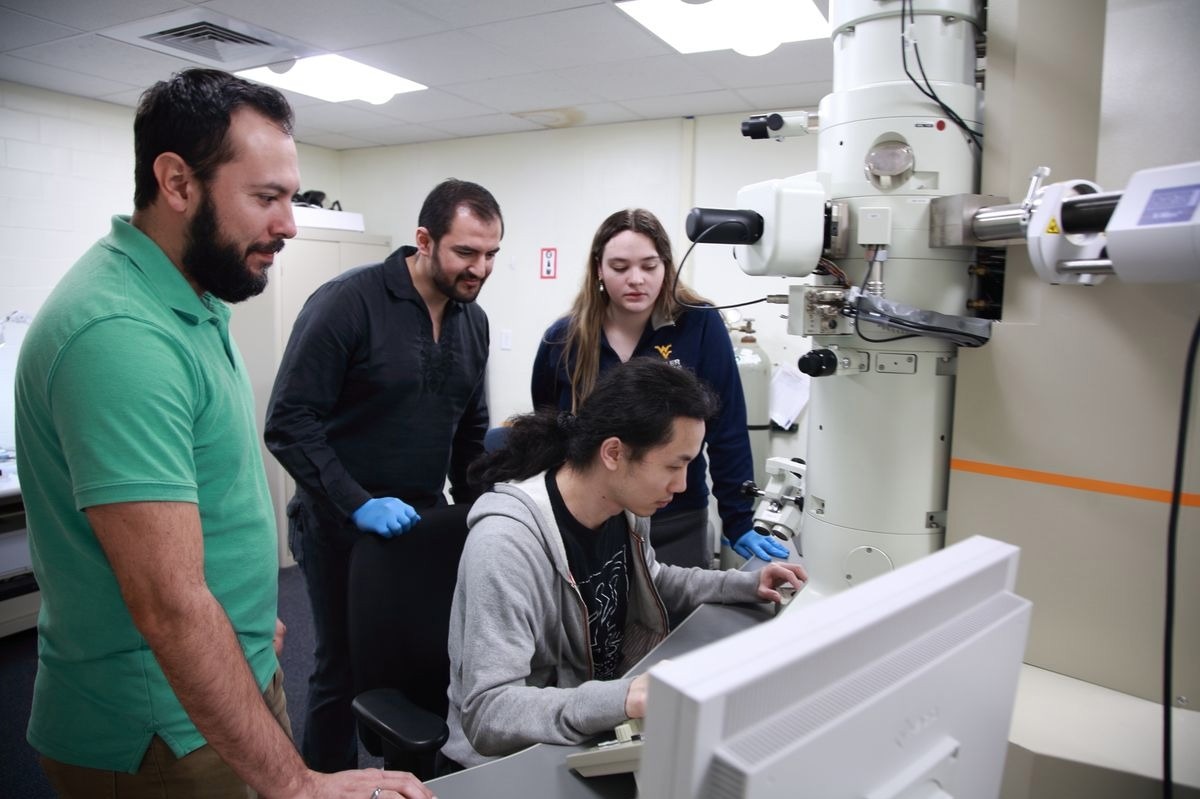West Virginia University scientists have created a material that has the ability to decrease the amount of heat that power plants emit into the atmosphere.
 WVU researchers Sergio Andres Paredes Navia, Cesar Octavio Romo de la Cruz, Liang Liang, and Ellena Gemmen use an electron microscope to study the nanostructure of a new oxide ceramic material with the potential to make thermoelectric generators efficient enough to capture a significant portion of the waste heat that industrial systems like power plants emit. Image Credit: West Virginia University.
WVU researchers Sergio Andres Paredes Navia, Cesar Octavio Romo de la Cruz, Liang Liang, and Ellena Gemmen use an electron microscope to study the nanostructure of a new oxide ceramic material with the potential to make thermoelectric generators efficient enough to capture a significant portion of the waste heat that industrial systems like power plants emit. Image Credit: West Virginia University.
An oxide ceramic material developed by a team guided by Xueyan Song, Professor and George B. Berry Chair of Engineering at the Benjamin M. Statler College of Engineering and Mineral Resources, resolves a long-standing efficiency problem plaguing thermoelectric generators. These devices can produce electricity from heat, including heat emissions from power plants, contributing to global warming.
The innovative oxide ceramic Song’s group developed “achieved a record-high performance that had been deemed impossible,” she said.
We demonstrated the best thermoelectric oxide ceramics reported in the field worldwide over the past 20 years, and the results open up new research directions that could further increase performance.
Xueyan Song, Professor and George B. Berry Chair of Engineering, Benjamin M. Statler College of Engineering and Mineral Resources, West Virginia University
Cesar Octavio Romo de la Cruz, Yun Chen, Liang Liang, and Sergio A. Paredes Navia all contributed to the study, which was funded by the National Science Foundation for $639,784. The findings have been published in Renewable and Sustainable Energy Reviews.
Oxide ceramics are related to materials such as porcelain, pottery, clay bricks, cement, and silicon, but they contain different metallic elements. These materials are tough, resistant to heat and corrosion, are ideal for high-temperature air applications and can be used to make thermoelectric generator components.
Oxide ceramics, on the other hand, have “polycrystalline” structures made up of multiple connected crystals. Engineers have difficulty developing large-scale thermoelectric applications for those materials because the “grain boundaries,” or points where the crystals meet, inhibit the current and electron flow that powers thermoelectric generators.
That major hurdle was turned into a stepping stone by Song’s team.
We intentionally added ‘dopants,’ or metal ions, into the polycrystal ceramics, driving special kinds of dopants to segregate to the grain boundaries. That’s how we turned the unavoidable and detrimental grain boundaries into electricity-conducting pathways, significantly improving thermoelectric performance.
Romo de la Cruz, Postdoctoral Researcher, West Virginia University
The study addresses the growing issue of waste heat, which contributes to climate change and is a byproduct of most operations that transform fuel into power. When lightbulbs become hot to the touch, they emit waste heat, which is ineffective extra energy that does not contribute to their primary function of producing light.
Waste heat is discharged into the atmosphere by systems ranging from power plants to home heating systems to automobiles. The global market for systems that recover it is expected to exceed $70 billion by 2026.
Heat is used to make almost everything from food to metals and electricity. But during those processes, around 60% of the energy produced is unproductively released to the environment in the form of heat. Waste heat recovery will play an increasingly key role in balancing growing demand for electricity against the carbon footprint of industrial processes. Thermoelectric oxide ceramics like ours come into play by substantially improving the ability of thermoelectric generators to convert waste heat into electricity.
Romo de la Cruz, Postdoctoral Researcher, West Virginia University
Thermoelectric generators are an exciting waste heat recovery technology, partly because they are simple to operate and maintain. A strong thermoelectric generator can grasp a substantial amount of waste heat from a power plant.
But “for the majority of applications, thermoelectric technology is too inefficient to be economical. Thermoelectric’s lack of effectiveness in converting energy severely hampers the development of thermoelectric devices, even though they are desperately needed,” Song says.
Her lab resolved the issue by using nanostructure engineering, which involves manipulating the crystal structure of a ceramic on an atomic scale that can only be seen with an electron microscope, to generate a dense, textured polycrystalline material that surpassed current single-crystal materials.
Even though tweaking the performance of different thermoelectric materials has prompted intense theoretical and experimental work for decades, Song believes her facility is the first to illustrate a substantial increase in the efficiency of energy generation from heat through nano- and atomic-scale engineering of grain boundaries between crystals for bulk oxide ceramics.
Song concludes, “This work is at the cusp for large-scale, high-temperature waste heat recovery. It leads toward a new era for oxide ceramics and aligns with the U.S. Department of Energy’s Industrial Heat Shot initiative to develop cost-competitive industrial heat decarbonization technologies with at least 85% lower greenhouse gas emissions by 2035. Our findings could facilitate and accelerate materials design that is magnitudes higher than the current state of the art.”
Journal Reference:
Romo-De-La-Cruz, C.-O., et al. (2023). Entering new era of thermoelectric oxide ceramics with high power factor through designing grain boundaries. Renewable and Sustainable Energy Reviews. doi.org/10.1016/j.rser.2023.113186.